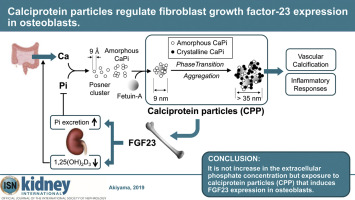当前位置:
X-MOL 学术
›
Kidney Int.
›
论文详情
Our official English website, www.x-mol.net, welcomes your
feedback! (Note: you will need to create a separate account there.)
Calciprotein particles regulate fibroblast growth factor-23 expression in osteoblasts.
Kidney International ( IF 14.8 ) Pub Date : 2019-11-09 , DOI: 10.1016/j.kint.2019.10.019 Ken-Ichi Akiyama 1 , Yutaka Miura 2 , Hirosaka Hayashi 2 , Asuka Sakata 3 , Yoshitaka Matsumura 4 , Masaki Kojima 4 , Ken Tsuchiya 5 , Kosaku Nitta 5 , Kazuhiro Shiizaki 2 , Hiroshi Kurosu 2 , Makoto Kuro-O 6
Kidney International ( IF 14.8 ) Pub Date : 2019-11-09 , DOI: 10.1016/j.kint.2019.10.019 Ken-Ichi Akiyama 1 , Yutaka Miura 2 , Hirosaka Hayashi 2 , Asuka Sakata 3 , Yoshitaka Matsumura 4 , Masaki Kojima 4 , Ken Tsuchiya 5 , Kosaku Nitta 5 , Kazuhiro Shiizaki 2 , Hiroshi Kurosu 2 , Makoto Kuro-O 6
Affiliation

|
Fibroblast growth factor-23 (FGF23) is a hormone indispensable for maintaining phosphate homeostasis. In response to phosphate intake, FGF23 is secreted from osteocytes/osteoblasts and acts on the kidney to increase urinary phosphate excretion. However, the mechanism by which these cells sense phosphate intake remains elusive. Calciprotein particles are nanoparticles of calcium-phosphate precipitates bound to serum protein fetuin-A and are generated spontaneously in solution containing calcium, phosphate, and fetuin-A to be dispersed as colloids. In cultured osteoblastic cells, increase in either calcium or phosphate concentration in the medium induced FGF23 expression, which was dependent on calciprotein particle formation. When transition of calcium-phosphate precipitates from the amorphous phase to the crystalline phase was blocked by bisphosphonate, the calciprotein particle size was reduced and FGF23 expression was augmented, suggesting that small calciprotein particles containing amorphous calcium-phosphate precipitates function as a more potent FGF23 inducer than larger calciprotein particles containing crystalline calcium-phosphate precipitates. In mice, bolus phosphate administration by oral gavage transiently increased circulating calciprotein particle levels followed by a modest increase in FGF23 expression and serum FGF23 levels. However, continuous dietary phosphate load induced robust and persistent increase in circulating calciprotein particles and FGF23 levels. We confirmed by in vivo imaging that calciprotein particles injected intravenously extravasated into the bone marrow and were deposited on the inner surface of the bone, indicating that these particles have direct access to osteoblasts. Thus, we propose that osteoblasts induce FGF23 expression and secretion when they sense an increase in extracellular calciprotein particles following phosphate ingestion.
中文翻译:

钙蛋白颗粒调节成骨细胞中成纤维细胞生长因子-23的表达。
成纤维细胞生长因子23(FGF23)是维持磷酸盐体内稳态必不可少的激素。响应于磷酸盐的摄入,FGF23从骨细胞/成骨细胞中分泌,并作用于肾脏以增加尿中磷酸盐的排泄。但是,这些细胞感知磷酸盐摄入的机制仍然难以捉摸。钙蛋白颗粒是结合到血清蛋白质胎球蛋白-A上的磷酸钙沉淀的纳米颗粒,并在含有钙,磷酸盐和胎球蛋白-A的溶液中自发产生,以胶体形式分散。在培养的成骨细胞中,培养基中钙或磷酸盐的浓度增加会诱导FGF23表达,这取决于钙蛋白颗粒的形成。当磷酸钙沉淀物从无定形相到结晶相的转变被双膦酸盐阻止时,钙蛋白的粒径减小,FGF23表达增加,这表明含有无定形磷酸钙沉淀物的钙化蛋白小颗粒起着更有效的FGF23诱导剂的作用。比包含结晶性磷酸钙沉淀的较大钙蛋白颗粒要大。在小鼠中,通过口服强饲法给予的磷酸盐大剂量短暂增加循环钙蛋白水平,然后适度增加FGF23表达和血清FGF23水平。然而,持续的饮食磷酸盐负荷导致循环钙蛋白颗粒和FGF23水平的强劲而持续的增加。我们通过体内成像证实静脉注射的钙蛋白颗粒渗入骨髓,并沉积在骨骼的内表面,表明这些颗粒可直接进入成骨细胞。因此,我们提出当成骨细胞感觉到磷酸盐摄入后细胞外钙蛋白颗粒的增加时诱导成骨细胞FGF23的表达和分泌。
更新日期:2019-11-11
中文翻译:

钙蛋白颗粒调节成骨细胞中成纤维细胞生长因子-23的表达。
成纤维细胞生长因子23(FGF23)是维持磷酸盐体内稳态必不可少的激素。响应于磷酸盐的摄入,FGF23从骨细胞/成骨细胞中分泌,并作用于肾脏以增加尿中磷酸盐的排泄。但是,这些细胞感知磷酸盐摄入的机制仍然难以捉摸。钙蛋白颗粒是结合到血清蛋白质胎球蛋白-A上的磷酸钙沉淀的纳米颗粒,并在含有钙,磷酸盐和胎球蛋白-A的溶液中自发产生,以胶体形式分散。在培养的成骨细胞中,培养基中钙或磷酸盐的浓度增加会诱导FGF23表达,这取决于钙蛋白颗粒的形成。当磷酸钙沉淀物从无定形相到结晶相的转变被双膦酸盐阻止时,钙蛋白的粒径减小,FGF23表达增加,这表明含有无定形磷酸钙沉淀物的钙化蛋白小颗粒起着更有效的FGF23诱导剂的作用。比包含结晶性磷酸钙沉淀的较大钙蛋白颗粒要大。在小鼠中,通过口服强饲法给予的磷酸盐大剂量短暂增加循环钙蛋白水平,然后适度增加FGF23表达和血清FGF23水平。然而,持续的饮食磷酸盐负荷导致循环钙蛋白颗粒和FGF23水平的强劲而持续的增加。我们通过体内成像证实静脉注射的钙蛋白颗粒渗入骨髓,并沉积在骨骼的内表面,表明这些颗粒可直接进入成骨细胞。因此,我们提出当成骨细胞感觉到磷酸盐摄入后细胞外钙蛋白颗粒的增加时诱导成骨细胞FGF23的表达和分泌。









































 京公网安备 11010802027423号
京公网安备 11010802027423号